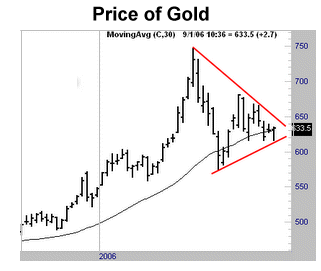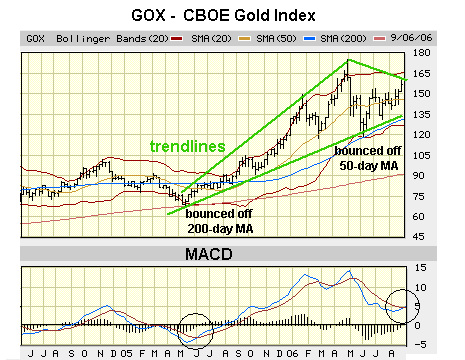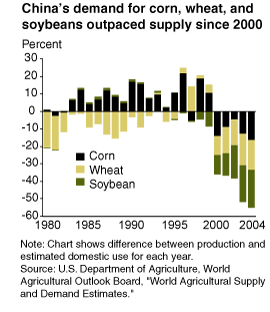

|
| weblog/wEssays archives | home | |
|
Protecting Capital IV: Commodities (September 8, 2006)  For your consideration: two charts of the commodity that people love to love or love to
hate: gold. What is clearly visible in the first one is what technical analysts call
a wedge. The general view of a wedge is that it presages either a big break down or a
big break up.
For your consideration: two charts of the commodity that people love to love or love to
hate: gold. What is clearly visible in the first one is what technical analysts call
a wedge. The general view of a wedge is that it presages either a big break down or a
big break up.
As we ponder which way POG (as price of gold is affectionately known) might go in the near future, let's look at a longer term chart of the GOX, a basket of gold mining stocks which make up the CBOE (Chicago Board of Exchange) Gold Index. (This chart displays the activity from June 2004 to the present.) 
I have added some trendlines, which show that the index has been in an upward trend for some time. The recent spike and decline has set up the above-mentioned wedge, but technically, there are several reasons to believe that gold remains in a long-term uptrend. 1) The index has bounced off major support levels (the 200-day simple moving average and the 50-day simple moving average), and the MACD (moving average convergence-divergence) chart is showing a bottoming formation which in the past presaged a major, sustained rise in the index. Fundamentally, the price of gold reflects the value of the dollar and the general "fear factor" in the marketplace. When times were confidently euphoric in the late 90s, gold was hitting 20-year lows. No one was interested in a commodity which had been dropping for 20 years. But as times have grown more uncertain, gold has reflected this anxiety by rising inexorably since the dot-com crash of 2000. Those who believe we are entering a deflationary period, in which cash grows in value as the price of goods and services drops, have little reason to turn their rising-in-value dollars for gold. Those who believe the Wall Street nostrums about the "Goldilocks economy" in which GDP growth and inflation both stay around 2% also have no reason to buy a commodity (or the miners which produce it) which produces no dividend and which hedges a dollar which is basically (in their view) benign. Those who believe the inflationary pressures which are building as a result of inflationary expansion of the money supply, the tripling in the cost of oil and the unabated rise in the costs of domestic labor benefits, medical expenses, etc. have a number of reasons to own gold or gold mining stocks. As inflation gnaws away at the value of cash and the value of other asset classes drops in a stagflationary malaise, gold at least holds out the possibility of retaining its value, i.e. rising as the dollar drops.  No one knows what the price of gold or mining stocks will do, next week, next month or
next year, but those are the basic scenarios. Some analysts, for instance,
Louise Yamada Technical Research
Advisors, believe that both gold and agricultural commodities are in 20-year uptrends.
No one knows what the price of gold or mining stocks will do, next week, next month or
next year, but those are the basic scenarios. Some analysts, for instance,
Louise Yamada Technical Research
Advisors, believe that both gold and agricultural commodities are in 20-year uptrends.
As for agricultural commodities, consider this chart of the demand for grains in China. If this demand is sustainable--and there are reasons to think it might be, such as the loss of cropland in China due to desertification and urbanization, the rising wealth of the populace (and hence their growing appetite for grain-fed poultry, pork and beef) and perhaps even the changing fortunes of agricultural areas in an era of rising global temperatures-- then grains and perhaps the lands which produce it might well become more valuable. The danger in any commodity, however, is that new supply may rise to meet or even exceed demand. It is only when oil, gold and grain production cannot meet demand that prices will rise in a sustainable fashion. Are we at that point? Those who give credence to long cycles see the past six years of commodity price increases as only the first stage of a much longer cycle. No one knows if this will prove true, but the rise of India and China certainly makes a fundamental case for that position. For more on this subject and a wide array of other topics, please visit my weblog. copyright © 2006 Charles Hugh Smith. All rights reserved in all media. I would be honored if you linked this wEssay to your site, or printed a copy for your own use. |
||
| weblog/wEssays | home |